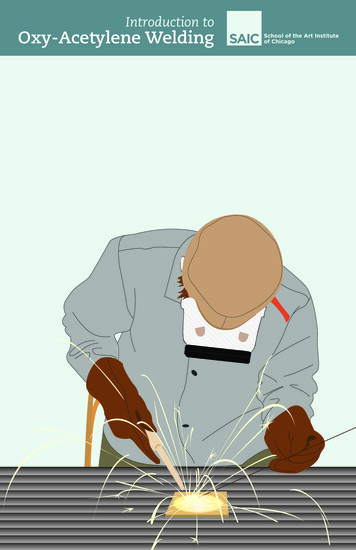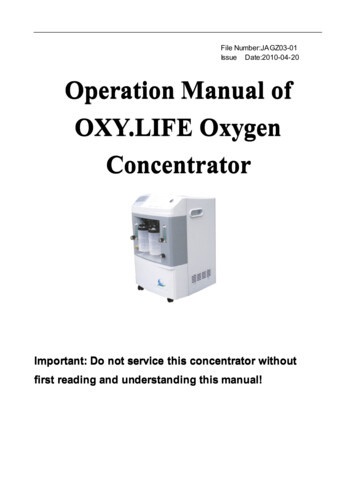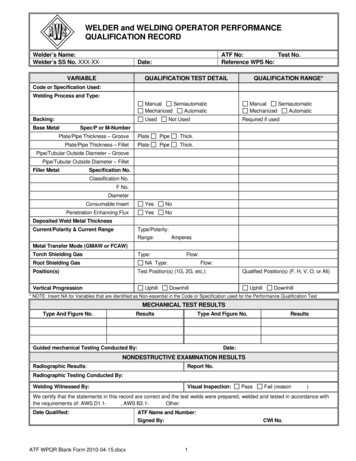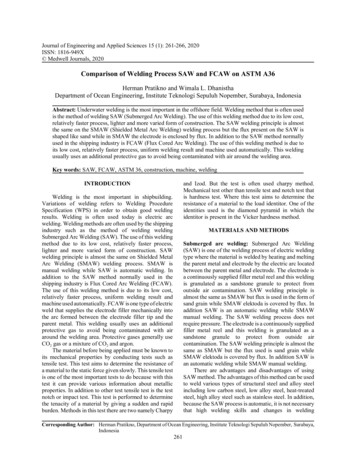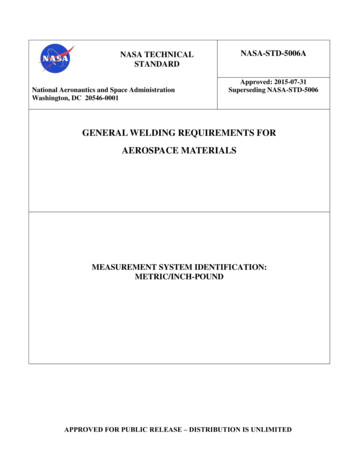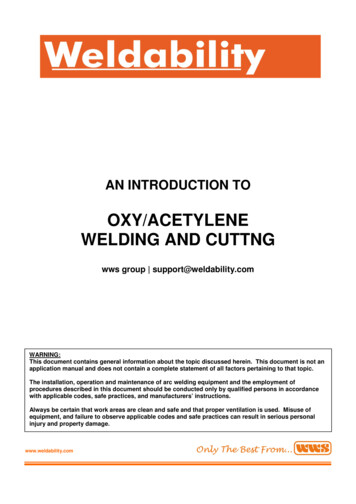
Transcription
AN INTRODUCTION TOOXY/ACETYLENEWELDING AND CUTTNGwws group support@weldability.comWARNING:This document contains general information about the topic discussed herein. This document is not anapplication manual and does not contain a complete statement of all factors pertaining to that topic.The installation, operation and maintenance of arc welding equipment and the employment ofprocedures described in this document should be conducted only by qualified persons in accordancewith applicable codes, safe practices, and manufacturers’ instructions.Always be certain that work areas are clean and safe and that proper ventilation is used. Misuse ofequipment, and failure to observe applicable codes and safe practices can result in serious personalinjury and property damage.www.weldability.com
IntroductionOxygen/Acetylene welding, or “Gas Welding”, is a process which relies on combustion of oxygen andacetylene. When mixed together in correct proportions within a hand-held torch or blowpipe, a hot flame isproduced with a temperature of about 3,200 C. The chemical action of the oxy/acetylene flame can be adjustedby changing the ratio of the volume of oxygen to acetylene, using the valves on the torch or blowpipe.EquipmentOxy/acetylene equipment isportable and easy to use. Itcomprises oxygen and acetylenegases stored under pressure insteel cylinders. The cylindersshould be fitted with regulators, tocontrol the pressure and flow ofgases. Flexible hoses are used toconnect the regulators to the torchor blowpipe. Specially designedsafety devices, called flame trapsor “Flashback Arrestors” are fittedbetween the hoses and theregulators. Flashback arrestorsprevent flames generated by a'flashback' from reaching thecylindersFlashbacksA flashback is a rapid, highpressure flame travelling back upthe gas hoses, caused by weldingor cutting at incorrect pressuresettings, or from blockage oroverheating of the nozzle (forexample by operating with thenozzle too close to the material)Flashbacks can result in extremelydangerous cylinder ignition andmust be prevented by proper useof working Flashback Arrestors.Lighting-Up ProcedureTo begin oxygen/acetylene welding or cutting, open theFig. 1 Oxy/Acetylene Equipmentcylinder valves slowly by means of the cylinder key(s).Do not open suddenly or there may be serious damage to the regulator and the possibility of an accident.Open the cylinder valve spindles one turn only. Open the fuel gas control valve on the blowpipe and adjust theregulator to give the correct working pressure (see chart on page 13), this ensures that any air or oxygen ispurged from the hose. Repeat the procedure for the oxygen side.Light the gas by means of a suitable sparklighter making sure that the sparklighter is held at right angles to thenozzle. Do not use liquid igniters (such as cigarette lighters) as the vapour/gas combination can be dangerous.Reduce or increase the acetylene supply to the blowpipe valve until the flame just ceases to smoke.Slowly increase the oxygen via the blowpipe control valve until the white inner cone in the flame is sharplydefined with the merest trace of an acetylene haze. The blowpipe is now correctly adjusted.www.weldability.com support@weldability.compage 2 of 13
WELDING TECHNIQUESLeftward WeldingLeftward Welding is used on steel for flanged edge welds, for unbevelled plates up to 5.0mm (3/16in). It is alsothe method usually adopted for cast iron and non-ferrous metals. Welding is started at the right-hand end of thejoint and proceeds towards the left.Fig. 2 Leftward weldingThe blowpipe is given a forward motion with a slight sideways movement to maintain melting of the edges ofboth plates at the desired rate and the welding rod is moved progressively along the weld seam – see fig. 2.The sideways motion of the blowpipe should be restricted to a minimum.Rightward and all position rightward weldingRightward welding is recommended for steel plate over 5.0mm (3/16in) thick. Plates from 5.0mm to 8.0mm(3/16in to 5/16in) need not be bevelled; over 8.0mm (5/16in) the edges are bevelled to 30o to give an includedangle of 60o for the welding V. Suitable for horizontal/vertical position.Fig. 3 Rightward WeldingThe weld is started at the left-hand end and moves towards the right with the blowpipe flame preceding the fillerrod in the direction of travel. The rod is given a circular forward motion and the blowpipe is moved steadilyalong the weld seam – See Fig. 3 This is faster than leftward welding and consumes less gas; the V angle issmaller, less filler rod is used and there is less distortion. The all-position rightward technique is a modificationof the above and is particularly suitable for mild steel plate and pipe in the vertical and overhead position – SeeFig. 4 on page 4.www.weldability.com support@weldability.compage 3 of 13
Fig. 4 All-position rightward welding. Butt-welds in mild 5 - 8mm (3/16 - 5/16in) thick.www.weldability.com support@weldability.compage 4 of 13
The advantages are that it enables the welder to obtain a uniform penetration bead and an even build-up,particularly in fixed position welding; the welder can work with complete freedom of movement and has a clearview of the weld pool and the fusion zone of the joint. Considerable practice is required to become familiar withthis technique even by operators skilled in normal downhand rightward welding. An apparent undercutting ofthe plate surface at the edges of the weld bead is a fault to which this technique is prone but this can becontrolled by appropriate manipulation of the rod and flame. The rod and blowpipe angle should be adjusted togive adequate control of the molten metal as in normal rightward welding.Fig. 5 Vertical welding, single-operator for plate thicknesses up to 5.0mm (3/16in)www.weldability.com support@weldability.compage 5 of 13
Vertical WeldingVertical welding may be used on unbevelled steel plate up to 3mm (1/8in) thickness and up to 15mm (5/8in)when two welders are employed working on both sides of the joint; welding starts at the bottom and proceedsvertically. See Fig. 5 and 6 for methods of blowpipe and welding rod manipulation for single-operatortechniques.When the two-operator method is used, the two welders must be trained to work in harmony.Fig.6 Vertical welding, two operators for plates thicker than 5.0mm (3/16in)www.weldability.com support@weldability.compage 6 of 13
Fig. 7 Edge preparationswww.weldability.com support@weldability.compage 7 of 13
Bronze WeldingBronze Welding involves the use of alloy bronze rods and is used for making joints in copper, for joiningdissimilar metals, and for repairs to cast iron.Among the rods used are fluxobronze, a flux-coated silicon bronze, plain silicon bronze, plain nickel bronze andmanganese bronze with suitable flux.It is essential that the edges of the materials should not be melted but merely raised to red heat. For examplewhen bronzewelding cast iron, a manganese bronze rod should be used; this melts at 895º C, well below themelting point of cast iron. The fracture, or the edges of the metal to be joined are prepared in the usualmanner, care being taken to ensure that all sharp edges are rounded-off and that they are absolutely clean.The joint so formed has excellent mechanical properties and providing there is no objection to dissimilarity incolour, bronzewelding can be recommended for a variety of purposes.Fractured castings should be pre-heated before welding.Depositing Hardfacing RodsThis is a process which consists of laying down a hard deposit which is very resistant to wear on a steel or castiron surface and finds wide application in building-up wearing services on well-boring drills, dies, picks, valveseats, punches, knives, crushing and excavating machinery, etc.For steel, the flame is adjusted to an excess of acetylene to give a feather of 1 ½ to 2 ½ times the length of thenormal neutral inner cone. The steel is raised to a dull red-heat and when the surface begins to ‘sweat’ the rodis deposited on the surface – see Fig. 8. Upon completion the work must be cooled slowly either in a furnace orin lime or mica dust.The deposition of hardfacing on cast iron is not as successful as on steel. Since cast iron cannot be made to‘sweat’ it is advisable first to fuse a layer of hardfacing rod on to the surface as in the case of welding using aCast Iron flux, then to ‘sweat’ a second layer onto the previous deposit.Rods containing tungsten carbide are also deposited with this technique.Fig. 8 Hardfacing ProcedureBuilding-up worn surfaces (Hardfacing)For building-up surfaces subject to a large amount of wear it is usual to deposit a rod, which has special wearresisting properties. An excess acetylene flame is used to deposit the metal; the base metal is pre-heated, asstated above and when it begins to ‘sweat’ the rod is melted on to the surface. The weld metal should beadded in small deposits and the whole surface gradually built up to the required thickness. There is a widerange of high-carbon and alloy steel rods which, with appropriate flame adjustment, may be used for building upgear teeth, splines, keyways and worn parts in general.www.weldability.com support@weldability.compage 8 of 13
Nozzle MaintenanceDo not maltreat a nozzle. Do not use it as a hammer or lever.To clean nozzle orifices, sets of special nozzle cleaning reamers are available from your local distributor, seeFig.9. Should these not be available use a drill one size smaller than the orifice and work it up and downwithout twisting; the drill should be held in a pin vice. If the drill does not enter easily start with a smaller drillincreasing the size until the correct diameter is attained. Effective flame shape can only be maintained if gasorifices are sharp and square with the end of the nozzle. If a nozzle becomes damaged on the end, rub it downwith a sheet of fine emery laid on a flat surface such as a sheet of glass taking care to keep to keep the nozzlesquare with the rubbing service. The orifice should then be cleaned out as described above. The nozzle hasbeen designed to make this reconditioning possible.DO NOT use other than recommended wire reamers or broaches to clean out the orifices.Fig.9 Nozzle Cleaningwww.weldability.com support@weldability.compage 9 of 13
Type 3 Shank & CutterL/W Shank & CutterNM Style Cutting TorchFig. 10 Styles Of Cutting Torch Equipment (“blowpipes”)N.B. It is essential when using a combined outfit (Type 3 or L/W) to open the oxygen valve or the shank fully. Ifthis is not done there will be starvation of oxygen at the nozzle when the cutting oxygen lever is depressed.CUTTING TECHNIQUESGeneralAssemble the equipment and arrange the material to be cut in a convenient position; faster cutting and asmoother finish are possible if rust and scale are removed from the path of the cut. Light up the nozzle andhold the blowpipe with the nozzle at right angles to the plate and apply the heating flame to the edge of thematerial furthest from the operator. A spade or nozzle attached to the nozzle is of assistance in holding theblowpipe steady.When the edge of the metal attains a bright red heat, operate the cutting oxygen lever and draw the blowpipetowards the body along the line of cut at a speed recommended in the data tables.The above remarks apply to the severance of mild steel plate of normal thickness. The following points shouldbe noted for differing cutting requirements.Fig. 11 Cutting torch position basicswww.weldability.com support@weldability.compage 10 of 13
Thick MaterialBecause of heavy gas consumption when cutting thick material, ensure that there is an adequate supply of fuelgas and use a battery of oxygen cylinders coupled together or pipeline supplies. On very thick material, a cutmay be started on the bottom face; gradually work up the edge with the blowpipe until the top is reached thencontinue the cut in the usual manner.Painted and Galvanised MaterialClean the surface before starting to cut. It is often an advantage to incline the tip of the nozzle toward the bodyto help to undercut paint or scale. Unless ventilation is very good fume extraction should be installed at thepoint of cutting. In some cases it may be necessary to use a respirator as well.Round BarNick the bar with a chisel at the point where cutting is to start, alternatively apply the end of a piece of steel wireheated to a bright red.Hole CuttingFor cutting holes in mild steel plate or pipe, mark out the area to be removed; cutting should be commencedwithin the area that will become scrap.Within the scrap area, heat a spot to a bright red heat then very slowly operate the cutting oxygen control until ahole is pierced through the material. Now move the blowpipe at cutting speed to the edge of the area to beremoved and follow round the marked out contour until the scrap portion is severed from the parent metal.When using a pierce start it is important that the cutting oxygen valve is opened slowly to avoid a splash of hotmetal and that the nozzle be presented at a slight angle so as to avoid slag being thrown back onto the nozzle.Cast IronApply the technique shown in Fig.12. The heating flame should be trimmed to give a large access of acetyleneso that the cone has a length of 50 to 75mm (2 to 3in) before cutting oxygen is turned on. Only high pressuredissolved acetylene can be used for cutting cast iron.It is not possible to cut a clean edge and because of the large amount of heat produced it is advisable to weargauntlets and protective clothing.Fig.12 Cutting Cast Ironwww.weldability.com support@weldability.compage 11 of 13
Cutting Nozzle MaintenanceDo not maltreat a nozzle. Do not use it as a hammer or a lever.To clean nozzle orifices, sets of special nozzle cleaning reamersare available from your welding distributor, see Fig.13. Shouldthese not be available use a drill one size smaller than the orificeand work it up and down without twisting; the drill should be held ina pin vice. If the drill does not enter easily, start with a smaller drill,increasing the size until the correct diameter is attained. It is mostimportant that the small holes at the seating end of the nozzle arenot enlarged in any way, because this may alter the gas flow, andmake cutting very difficult.Effective pre-heat shape and cutting oxygen stream can only bemaintained if gas orifices are sharp and square with the end of thenozzle. If a nozzle becomes damaged on the end, rub it down witha sheet of fine emery laid on a flat surface such as glass, takingcare to keep the nozzle square with the cutting surface. Theorifices should then be cleaned out as described above. Thenozzle has been designed to make this reconditioning possible andas much as 3mm (1/18in) may be removed before a nozzlebecomes unserviceable.Fig.13 Nozzle cleaningN.B. High speed venture type nozzles and two piece propane nozzles should not be treated in this way. Seekadvice from your distributor.www.weldability.com support@weldability.compage 12 of 13
Typical Variables For Welding & CuttingSettings For Oxy/Acetylene Welding With Type 3 Welding EquipmentMild Steel ThicknessOperating PressureAcetyleneOxygenGas il/hft /h3l/hft .21013/83/323/161/45/163/81/2251 13Settings For Oxy/Acetylene Cutting With Type 3 or NM Cutting TorchesMild SteelThicknessmm InSheet¼6½13251502753100 4150 6200 8250 10300 12Operating pressureGas eneAcetyleneNozzleOxygenOxygensizebarpsibar psil/h ft3/h l/h ft3/h l/h ft3/h mm.m in.mAsnm1.520 0.14 2800288538531/321.825 0.14 280028 480 15 400 14510 203/642.130 0.21 31900 67 570 20 510 18480 191/162.840 0.14 24000 140 540 19 470 17400 161/163.2/3.5 45/50 0.14 24500 160 620 22 560 19300 121/163.5/4.2 50/60 0.14 24800 170 680 24 620 2220585/643.2/4.8 45/70 0.14 26800 240 850 30 790 2715063/323.2/5.5 45/80 0.21 39400 330 960 34 850 3012551/84.260 0.28 4 14800 510 1380 48 1250 4410041/85.375 0.28 4 21500 760 1560 55 1420 507531502/86.390 0.28 4 25000 880 1560 55 1420 50Settings For Oxy/Acetylene Gouging With Type 3 or NM Cutting ing 5bar0.50.50.55psi607585psi778www.weldability.com support@weldability.comGas t3/hl/hft3/hl/hft3/h368013099035905329340330 18706617006016270 575 page 13 of 13
Leftward Welding Leftward Welding is used on steel for flanged edge welds, for unbevelled plates up to 5.0mm (3/16in). It is also the method usually adopted for cast iron and non-ferrous metals. Welding is started at the right-hand end of the joint and proceeds t
